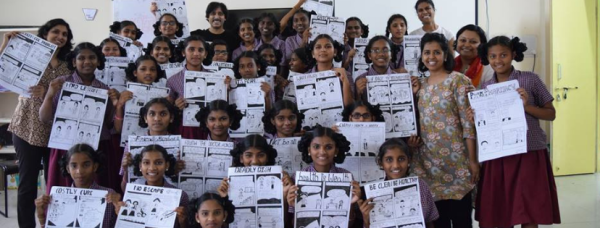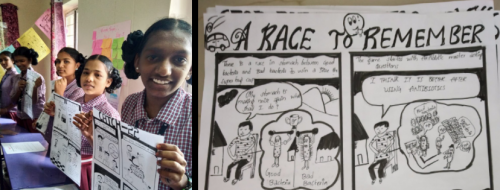Expert Spotlight: 5 Questions with SuperHeroes Against Superbugs
Children can change the world! So that’s why we were excited to meet the creators of Superheroes Against Superbugs, a program in India that aims to raise awareness about antibiotic resistance and superbugs and change behavior through comic books designed by children. Superheroes Against Superbugs was developed in collaboration with the WellcomeTrust/DBT India Alliance. We interviewed Ponnari Gottipati and Sarah Iqbal, the leaders of Superheroes Against Superbugs to learn more about their important work!
1. We love the idea of comic books to illustrate this global public health threat and as a way to engage young people! How did this concept come to life?
When we first set out to develop a program that aimed to spread awareness on antibiotic resistance, we were keen to design it such that its impact lasted beyond the duration of our program. We were also keen to work with children, who can be the real change-makers and possess unique creativity and imagination that we so desperately needed for this project. We felt the best way to do that would be to partner with children to develop creative and innovative tools to talk about the AMR issue. We thought that this approach would not only keep the children invested in the problem but their work could further encourage others to think about the issue. Initially we had planned to develop animations, short films or virtual reality games and were looking for the right collaborators to help us do this. However, we soon found our perfect partner in Mr. Sharad Sharma, founder of World Comics India and grassroots comics pioneer in India. The philosophy behind grassroots comics particularly appealed to us - giving voice to people and enabling them to take ownership of issues that affect them. Compared to its tech counterparts, grassroots comics is a cost effective, simple yet a powerful medium that enables us to express our stories visually and importantly, does not require one to be artistically skilled. Also, comics by their very nature appeal to children and adults alike so it's a great tool for engagement and communication.
At our workshops, our young superheroes with their inherent enthusiasm readily turned into cartoonists and simplified the complexities of antibiotic resistance in a delightful manner. The sense of ownership for their comics was enough motivation for the children to continue the conversations initiated during the workshop and they have been enthusiastically spreading the message since. While the local flavor of the comics helps the Indian audience connect deeply with the content, the issues discussed in the comics have relevance around the globe.
2. The pilot program launched in June 2018. What has happened since then? What were the key takeaways from the pilot and using creative communications to educate children and the community on this important public health issue?
These comics have been showcased at various avenues both within and outside the schools. A comic-zine is being compiled at the moment where each comic will be accompanied by a brief narration on each of the different issues touched upon by the children, for those unaware of the AMR problem. An animation film inspired by these comics is also in the pipeline. In fact, we went back to one of the schools and ideated with the children on what they would like to see in the animation. Their understanding of the complexities of antibiotic resistance and their out of the box thinking surprised us yet again!
There have been many lessons along the way but the most important takeaway for us was that the community (in this case the students and schools) need to recognize and own the problem and subsequently the solution, to ensure sustainability and action. We also realized as we went along that different socio-economic groups would understand and relate to the AMR issue differently - therefore, the public engagement approach and the health communication strategy must differ depending on the target audience. For example, in the government school most children came from lower socio-economic settings and could relate more to the hygiene and sanitation issues surrounding antibiotic resistance, as reflected in their stories. Whereas the children from the private school, who are from more affluent backgrounds were keen to narrate stories on misuse and overuse of antibiotics, perhaps a reflection of their easy access to medicines and healthcare in general. And of course, the biggest lesson was that comics are a powerful medium to engage with children even on complex issues.
3. Did each student make their own comic? Or was it one big comic book that the students worked on together? Can our readers download these materials?
Each of the 60 children from the 2 schools that participated in our pilot program made their own comic. So we had 60 comics at the end of our workshops! The comics covered various aspects of antibiotic resistance including, health and hygiene, misuse and overuse of antibiotics, environmental issues surrounding antibiotic resistance, misuse of antibiotics in animal farming and science behind antibiotic resistance. The comics have humor, irony, sarcasm and serve as a warning of the dangers of antibiotic resistance but almost always end on an optimistic note, giving out hope as is possible only for children.
We are working on making all the content from the workshops available online. Not just the comics but also the hands-on activities and games that were used to explain the science behind antibiotic resistance to the school children will be made available to anyone interested. So watch out!
4. What’s next with Superheroes Against Superbugs?!
The possibilities are endless because the AMR problem is extremely challenging and complex! One obvious step is to scale up the initiative and take it to different Indian cities. We would like to partner with research institutions to advance these efforts and to get biomedical researchers talking about this important issue to the public. We could also perhaps engage with other sections of the society like medical students or pharmacists and explore other mediums and tools of communication. But whatever we do, we intend to keep the fun element in our engagement approach intact!
5. In presenting your work, have you encountered other creative initiatives underway around the world or within India to educate and engage young people about antibiotic resistance?
e-Bug has brilliant material to engage with children of all age groups. There are also interesting animation films out there that explain the concept of antibiotic resistance in simple terms, we used some of these along with our games and activities in our workshops. We were encouraged to learn that the "Diary of a Staph" animation by CDDEP was developed based on an idea from a school student in Nepal. We also came across some interesting video games explaining resistance, one of them being the 'Superbugs' mobile game developed by Nesta targeting 11-16 year olds. ReACT Asia Pacific and Latin America have many programs for children, eg., Alforjo Educativa.
Superheroes Against Superbugs is unique in that the creative tools (i.e., the comics) are developed by the children themselves. We would also like to mention our other collaborators on this pilot without whom this project would not have been possible - Somdatta Karak (Centre for Cellular and Molecular Biology, Hyderabad, India) and Madhuri Dutta (George Institute for Global Health India)!
Learn more about Superheroes Against Superbugs:
https://www.facebook.com/SaSantibioticresistance/
https://www.indiaalliance.org/news/252




